10 Facts About Purple Sweet Potatoes You Should Know
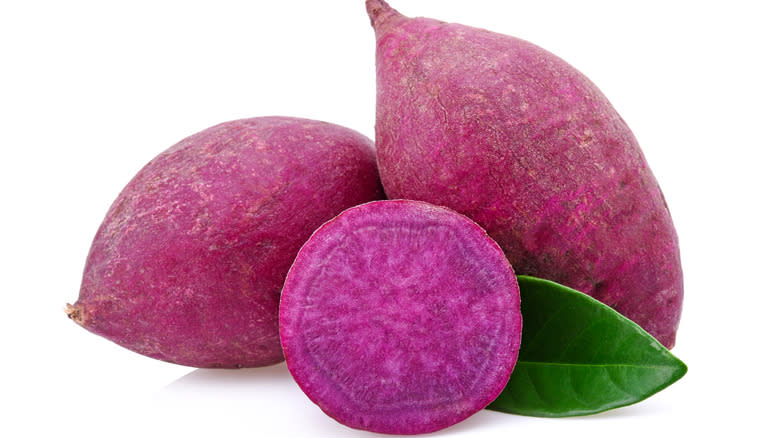
It's easy to get caught up in a cycle of eating the same thing week after week, but nothing cures boredom better than trying something new, especially when it comes to food. Next time you're feeling unenthused about the vegetables in your pantry or fridge, look for options outside of tried-and-true carrots, broccoli, and spinach. When your next bout of vegetable apathy hits, and you're strolling through the produce section at your grocery store feeling uninspired, don't be afraid to add a less conventional vegetable, like purple sweet potatoes, to your shopping cart.
Purple sweet potatoes have become more popular in recent years, captivating home cooks and chefs alike. If you're in a vegetable rut, purple sweet potatoes are the vegetable for you. They're nutritious and becoming more widely available, making it a lot easier to eat the rainbow.
Purple sweet potatoes are a root vegetable known for their distinctive bright purple skin and flesh. Not to be confused with Murasaki sweet potatoes, also known as Japanese sweet potatoes, which have purple skin but a muted, off-white flesh, purple sweet potatoes are purple inside and out. Their vibrant purple flesh is all-natural, no genetic modification required, and purple sweet potatoes are good for you, boasting a variety of nutrition and health benefits.
Read more: The 20 Best Olive Oils For Cooking
They're Not The Same As Ube
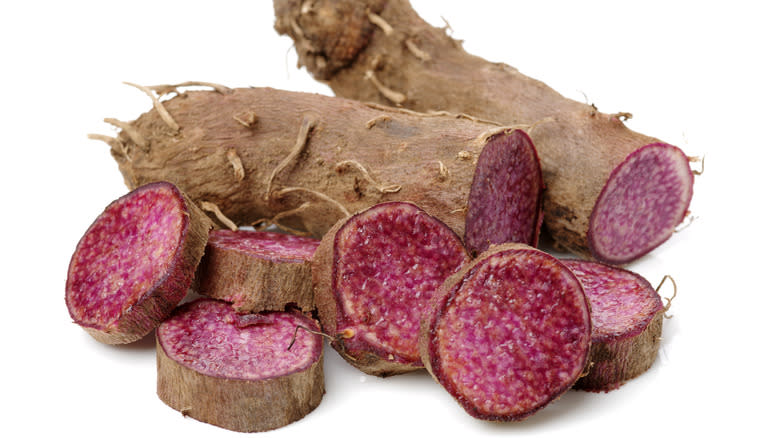
All purple potatoes are not created equally. Ube is another variety of tuber also known for its bright purple flesh. At first glance, you might mistake one for the other, and though some recipes claim the two are interchangeable, there are a number of differences. Ube may look like a purple sweet potato, but it's not.
Purple sweet potatoes, as their name suggests, are part of the sweet potato family. Their flesh is consistently a vibrant purple, and they grow underground. Ube is technically part of the yam family. It grows on a vine and has flesh ranging in color from light to dark purple. Hailing from Asia and the Philippines, ube is popular in Filipino cooking. It's primarily used in sweet dishes, like sweet potato pie, but purple sweet potatoes can be used in both sweet and savory recipes.
Another key difference between ube and purple sweet potatoes is their texture. As part of the yam family, ube has a harder, tougher skin similar to bark that must be peeled away before eating. Ube's flesh is typically starchier, closer to that of a standard white potato.
There Are Two Primary Varieties
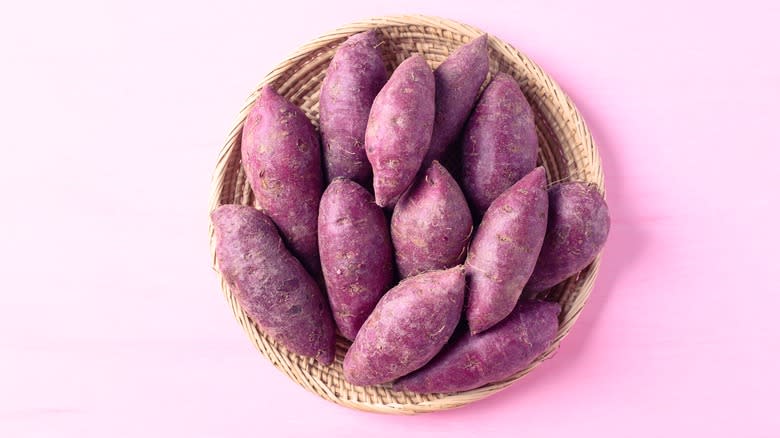
If you're not familiar with purple sweet potatoes, you might think they're all the same, but like most vegetables, there are many varieties. Charleston, Murasaki, Stokes, and Okinawan are a few of the most popular varieties. They all share some similarities, but there are distinctions between them.
The Charleston purple sweet potato has a thin, oblong shape with a heavy, solid, deep purple flesh that gets even darker when it's cooked. Murasaki sweet potatoes, also known as Japanese sweet potatoes, have bright purple skin with a white center. Their name stems from the Japanese word for purple, but they actually originate from Louisiana.
If you're buying purple sweet potatoes in the United States, you're likely buying either a Stokes or an Okinawan purple sweet potato. These are the two primary varieties most readily available here. Stokes purple sweet potatoes are thin and oblong in shape and known for their purple skin and dark purple flesh. One company, Friedas Branded Produce, produces all of the Stokes purple sweet potatoes in the country. Okinawan purple sweet potatoes have pale off-white skin and pale purple flesh. They're tubular in shape with narrow ends and thin, edible skin.
Purple Sweet Potatoes Are Rich In Vitamins And Nutrients

Purple sweet potatoes are not only pretty to look at, but they also pack a nutritional punch, offering a wide array of essential nutrients that contribute to overall health and well-being. These vibrant tubers are rich in vitamins, minerals, antioxidants, and dietary fiber, making them a valuable addition to a balanced diet.
Many of the health benefits are directly related to the potato's vivid purple color. The color is caused by an antioxidant called anthocyanin, which helps fight inflammation and other diseases. Stokes purple sweet potatoes are excellent sources of vitamin C, containing quadruple the amount of regular sweet potatoes. They're also excellent sources of vitamin A, which supports vision health, immune function, and skin health, and B vitamins, which are crucial for brain health and red blood cell production.
Purple sweet potatoes also boast a high mineral content. They are high in potassium, which helps regulate blood pressure and muscle function. They're also good sources of manganese and copper, which support bone health and collagen formation. Okinawan purple sweet potatoes, in particular, contain more than 150% more free-radical fighting antioxidants than fresh blueberries and four times the recommended daily amount of vitamin A.
Purple Potatoes Need More Cooking Time
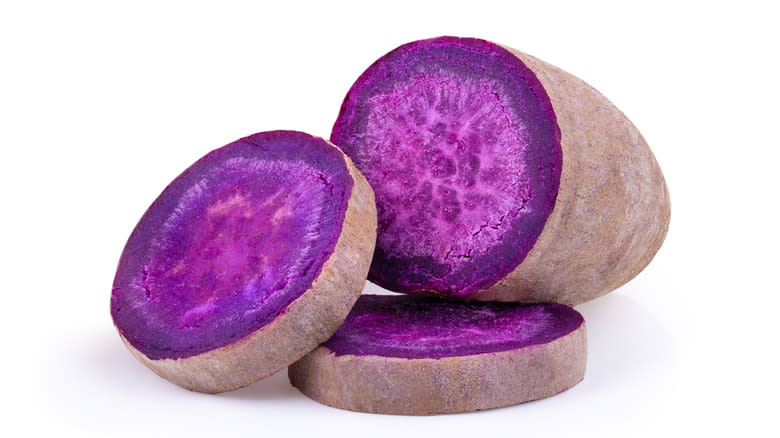
Purple sweet potatoes can be cooked in the same ways as standard sweet potatoes. They can be baked, roasted, and mashed, much like their orange counterparts. One of the defining characteristics of purple sweet potatoes, no matter the variety, is a firm, dense flesh. They are also naturally higher in starch content and drier than standard sweet potatoes.
Purple sweet potatoes typically require a longer cooking time compared to other varieties of sweet potatoes due to their density and high starch content. This denser texture makes it more difficult for heat to penetrate the sweet potato evenly. A longer cooking time is necessary to fully cook the potato and soften their flesh. Friedas Branded Produce, which grows the Stokes Purple Sweet Potato, recommends baking the spuds in a 350 F oven for one ½ to two hours. They also recommend wrapping the potatoes in foil. The foil allows you to get the best flavor out of a purple sweet potato as it helps the potatoes retain their moisture.
They Taste Slightly Different Than Regular Sweet Potatoes
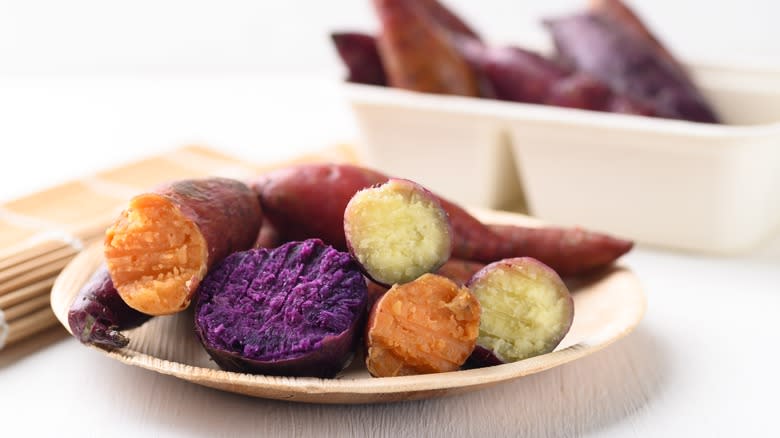
Sweet potatoes have such a distinctive taste that even if you took a bite blindfolded, most people would know immediately what they were eating, no matter how they were cooked. Whether you're tucking into a plate full of sweet potato fries, devouring a bowl of sweet potato gnocchi, or gliding your fork through a marshmallow-topped sweet potato casserole, there's no mistaking that familiar flavor.
Purple sweet potatoes have a flavor profile that differentiates them from other varieties. They are characterized by a delightful combination of sweetness and earthiness, with subtle nutty undertones, depending on the variety. Their understated yet complex taste sets them apart from the more straightforward sweetness of orange sweet potatoes.
There's debate about whether purple sweet potatoes are more or less sweet than standard sweet potatoes. Okinawan purple sweet potatoes are described as having a somewhat sweet taste. The sweetness of the Stokes variety of purple sweet potatoes is infused with floral notes, and some even compare the taste of the purple spuds to wine.
Avoid Storing Them In The Fridge
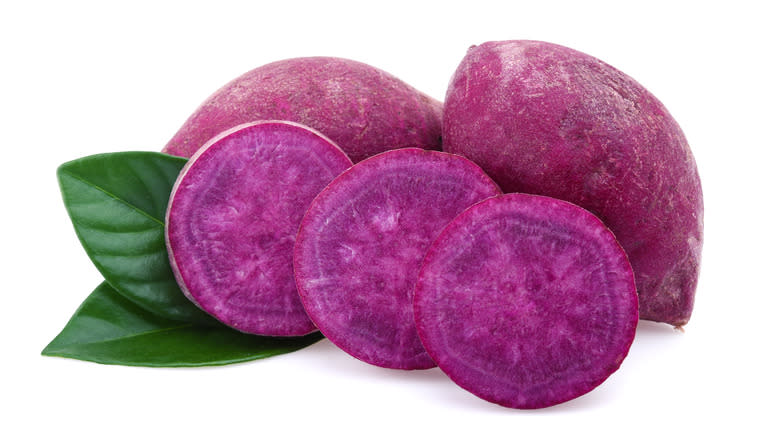
In most kitchens, the refrigerator is where food goes to live another day. The cold air helps extend the food's shelf life and slows bacteria growth, keeping food safe. However, not all foods, including purple sweet potatoes, are well-suited for the fridge's cooler temperature.
The cold air in your fridge could potentially damage your purple sweet potatoes. When stored at temperatures below 50 F, they become susceptible to chilling injury, which occurs when food is stored below its ideal temperature. Reactions include discoloration and loss of texture. It can also cause the potatoes to decay faster than normal. Refrigerating all varieties of potatoes can cause the potatoes to increase production of ethylene gas, which can cause them to deteriorate at a faster pace. Like regular potatoes, purple sweet potatoes are best stored in a well-ventilated pantry, drawer, or other completely dry and cool locations.
They Won't Last As Long As Regular Sweet Potatoes
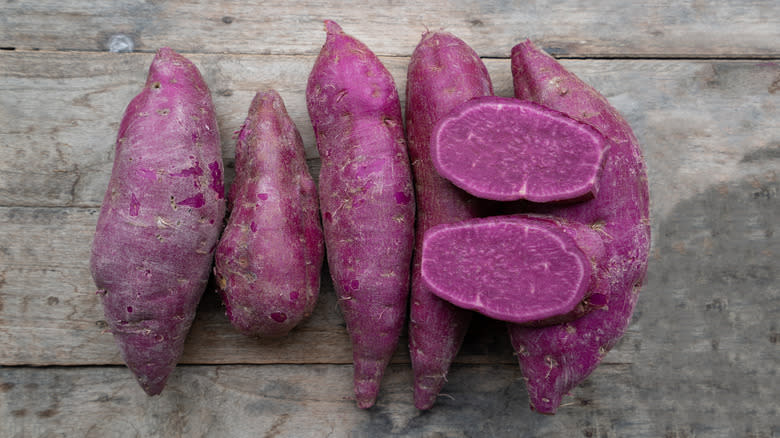
Potatoes, like root vegetables in general, are tough foods. They do not require especially gentle handling, and if they are stored correctly, potatoes can last for up to three months in your pantry. Who hasn't discovered a long-forgotten potato or two hiding in the back of a cabinet?
Traditional sweet potatoes are sadly not as hardy as regular potatoes. Their shelf life is slightly shorter. In the best-case scenario, sweet potatoes can last for as long as three to five weeks. Purple sweet potatoes have an even shorter shelf life. In general, they last one to two weeks if stored correctly. The potato's antioxidants are thought to contribute to a person's longevity when eaten often, but on its own, the Okinawan purple sweet potato should be cooked and eaten within a week before going bad and not being as ripe.
The Potatoes Originated In North Carolina And South America
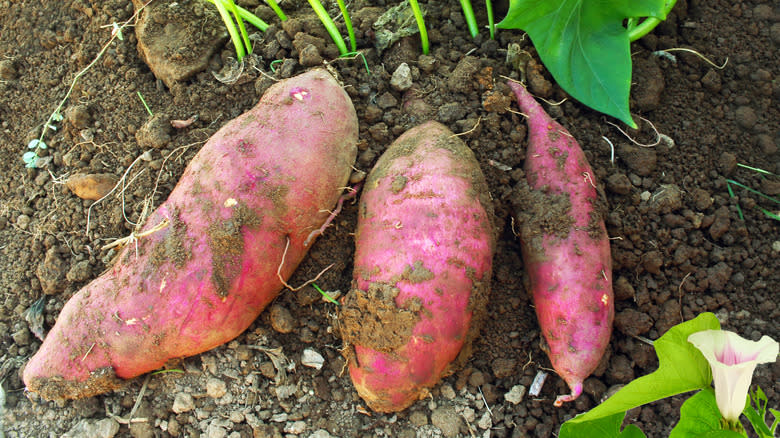
The Stokes purple sweet potato hails from North Carolina. It is named after Stokes County, North Carolina, where it was developed by Mike Sizemore. Sizemore propagated purple sweet potatoes that were gifted to him after his regular sweet potatoes won a ribbon at the state fair. He fell in love with the purple tubers, and the Stokes purple sweet potato was born. Sizemore began to market his potatoes in 2006, making them a relatively new addition to the produce section. Today, they're grown commercially in California and are available year-round.
Okinawan purple sweet potatoes, also known as Beni Imo, came to Okinawa, Japan by way of South America. They became popular there because they were easy to grow in Okinawa's subtropical climate. Japanese workers introduced the purple spuds to Hawaii in the early 20th century. Today, Okinawan purple sweet potatoes are common ingredients in many Hawaiian dishes, like mashed Okinawan sweet potatoes, where they are boiled and mashed with coconut milk, sugar, and salt.
They Shine In Sweet And Savory Recipes
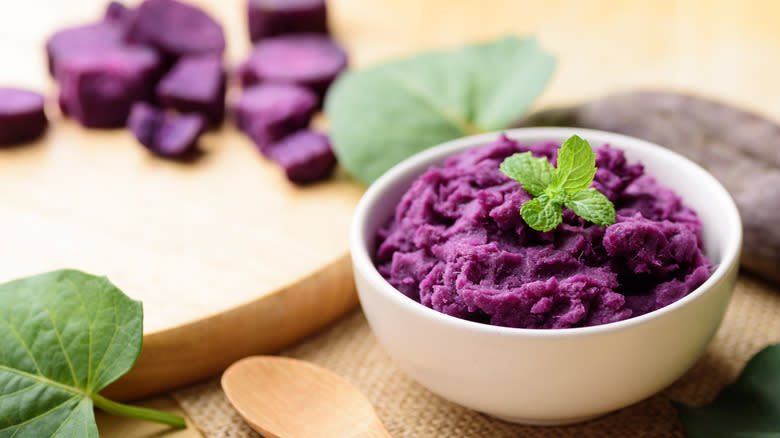
Sweet potatoes are known for their versatility in the kitchen. They work well with a variety of cooking methods and are delicious mashed, steamed, roasted, and baked. Their flavor pairs beautifully with a host of ingredients to create delectable sweets, like purple sweet potato tea cake, and tasty, savory creations, like a sweet potato tarte tartin. It's just as common to enjoy spicy sweet potato fries as having a sweet potato pie for dessert. The sweet potato casseroles topped with marshmallows that make their appearances on Thanksgiving tables each year can confuse matters even more. Is it sweet? Is it savory? A little of both?
Purple sweet potatoes are equally adaptable. As they've gained popularity in recent years, the number of recipes utilizing purple sweet potatoes has grown, but they can typically be easily substituted for standard sweet potatoes in most recipes (keep in mind you may need to extend your cooking time). You'll get the benefit of the purple sweet potato flavor and their vibrant color that will add a bit of whimsy to your recipes.
They're Available Year-Round
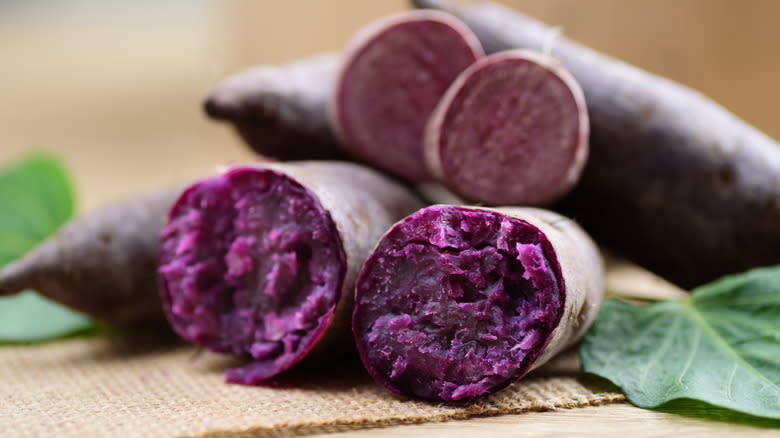
There are many reasons why eating seasonally is the best way to eat. Choosing to eat vegetables that are harvested and sold at their peak likely means you'll be enjoying them when they're most flavorful. Vegetables are typically less expensive when they're in season. Sweet potatoes are a staple in most grocery store produce sections, so they might not come to mind when you think of seasonal vegetables; however, purple sweet potatoes are available in season at specific times.
Okinawan sweet potatoes are available all year. The Okinawan potatoes available in the United States are grown in Hawaii. The warm climate there makes it easy for farmers to cultivate and harvest them year-round. The Stokes Purple sweet potato technically has a season that runs from September through June, but because they're mass-produced, you can usually find them in certain stores year-round. If you're in Hawaii, you'll be able to find the lesser-known Molokai purple sweet potatoes in stores there during a short season that runs from late spring to early summer.
Read the original article on Tasting Table

 Yahoo News
Yahoo News 
